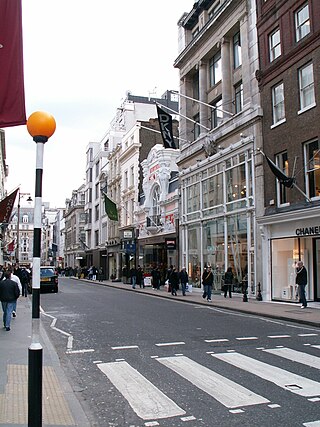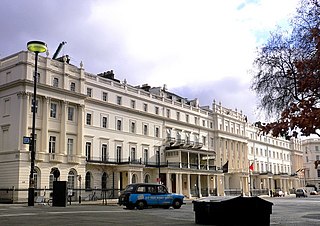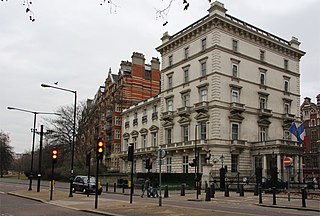
Soho is an area of the City of Westminster in the West End of London. Originally a fashionable district for the aristocracy, it has been one of the main entertainment districts in the capital since the 19th century.

Mayfair is an area of London, England, in the City of Westminster. It is in Central London and part of the West End. It is between Oxford Street, Regent Street, Piccadilly and Park Lane and one of the most expensive districts in the world.

Park Lane is a dual carriageway road in the City of Westminster in Central London. It is part of the London Inner Ring Road and runs from Hyde Park Corner in the south to Marble Arch in the north. It separates Hyde Park to the west from Mayfair to the east. The road has a number of historically important properties and hotels and has been one of the most sought after streets in London, despite being a major traffic thoroughfare.

Regent Street is a major shopping street in the West End of London. It is named after George, the Prince Regent and was laid out under the direction of the architect John Nash and James Burton. It runs from Waterloo Place in St James's at the southern end, through Piccadilly Circus and Oxford Circus, to All Souls Church. From there Langham Place and Portland Place continue the route to Regent's Park.

Belgravia is a district in Central London, covering parts of the areas of the City of Westminster and the Royal Borough of Kensington and Chelsea.

Bond Street in the West End of London links Piccadilly in the south to Oxford Street in the north. Since the 18th century the street has housed many prestigious and upmarket fashion retailers. The southern section is Old Bond Street and the longer northern section New Bond Street, a distinction not generally made in everyday usage.

Pall Mall is a street in the St James's area of the City of Westminster, Central London. It connects St James's Street to Trafalgar Square and is a section of the regional A4 road. The street's name is derived from pall-mall, a ball game played there during the 17th century, which in turn is derived from the Italian pallamaglio, literally "ball-mallet".

Savile Row is a street in Mayfair, central London. Known principally for its traditional bespoke tailoring for men, the street has had a varied history that has included accommodating the headquarters of the Royal Geographical Society at 1 Savile Row, where significant British explorations to Africa and the South Pole were planned; and more recently, the Apple office of the Beatles at 3 Savile Row, where the band's final live performance was held on the roof of the building.

Grosvenor Square is a large garden square in the Mayfair district of Westminster, Greater London. It is the centrepiece of the Mayfair property of the Duke of Westminster, and takes its name from the duke's surname "Grosvenor". It was developed for fashionable residences in the 18th century. In the 20th it had an American and Canadian diplomatic presence, and currently is mixed use, commercial.

Great Marlborough Street is a thoroughfare in Soho, Central London. It runs east of Regent Street past Carnaby Street towards Noel Street.

Grosvenor Group Limited is an internationally diversified property group, which traces its origins to 1677 and has its headquarters in London, England. It has a global reach, now in 62 international cities, with offices in 14 of them, operated on behalf of its owners, the Duke of Westminster and his family. It has four regional development and investment businesses and a portfolio of indirect investments. Its sectors include residential, office, retail, industrial, along with hotels.

Brook Street is an axial street in the exclusive central London district of Mayfair. Most of it is leasehold, paying ground rent to and seeking lease renewals from the reversioner, that since before 1800, has been the Grosvenor Estate. Named after the Tyburn that it crossed, it was developed in the first half of the 18th century and runs from Hanover Square to Grosvenor Square. The western continuation is called Upper Brook Street; its west end faces Brook Street Gate of Hyde Park. Both sections consisted of neo-classical terraced houses, mostly built to individual designs. Some of them were very ornate, finely stuccoed and tall-ceilinged, designed by well known architects for wealthy tenants, especially near Grosvenor Square, others exposed good quality brickwork or bore fewer expensive window openings and embellishments. Some of both types survive. Others have been replaced by buildings from later periods.

Coventry Street is a short street in the West End of London, connecting Piccadilly Circus to Leicester Square. Part of the street is a section of the A4, a major road through London. It is named after the politician Henry Coventry, secretary of state to Charles II.

Claud Stephen Phillimore, 4th Baron Phillimore was an English architect specialising in larger country houses who succeeded to his family's title in 1990.
Somerset House, was an 18th-century town house on the east side of Park Lane, where it meets Oxford Street, in the Mayfair area of London. It was also known as 40 Park Lane, although a renumbering means that the site is now called 140 Park Lane.

The Embassy of France in London is the diplomatic mission of France to the United Kingdom.

In British usage, the term townhouse originally referred to the opulent town or city residence of a member of the nobility or gentry, as opposed to their country seat, generally known as a country house or, colloquially, for the larger ones, stately home. The grandest of the London townhouses were stand-alone buildings, but many were terraced buildings.

South Audley Street is a major shopping street in Mayfair, London. It runs north to south from the southwest corner of Grosvenor Square to Curzon Street.

Dunraven Street is a street in London's Mayfair district. It was laid out in the 1750s as Norfolk Street, and in the 19th century was sometimes known as New Norfolk Street. In 1939, it was renamed Dunraven Street by London County Council, after the fourth Earl of Dunraven and Mount-Earl, a former resident of the street, who had been a member of the LCC.
This is a list of the etymology of street names in the London district of Mayfair, in the City of Westminster. It utilises the generally accepted boundaries of Mayfair viz. Marble Arch/Cumberland Gate and Oxford Street to the north, Regent Street to the east, Piccadilly to the south and Park Lane to the west.




















